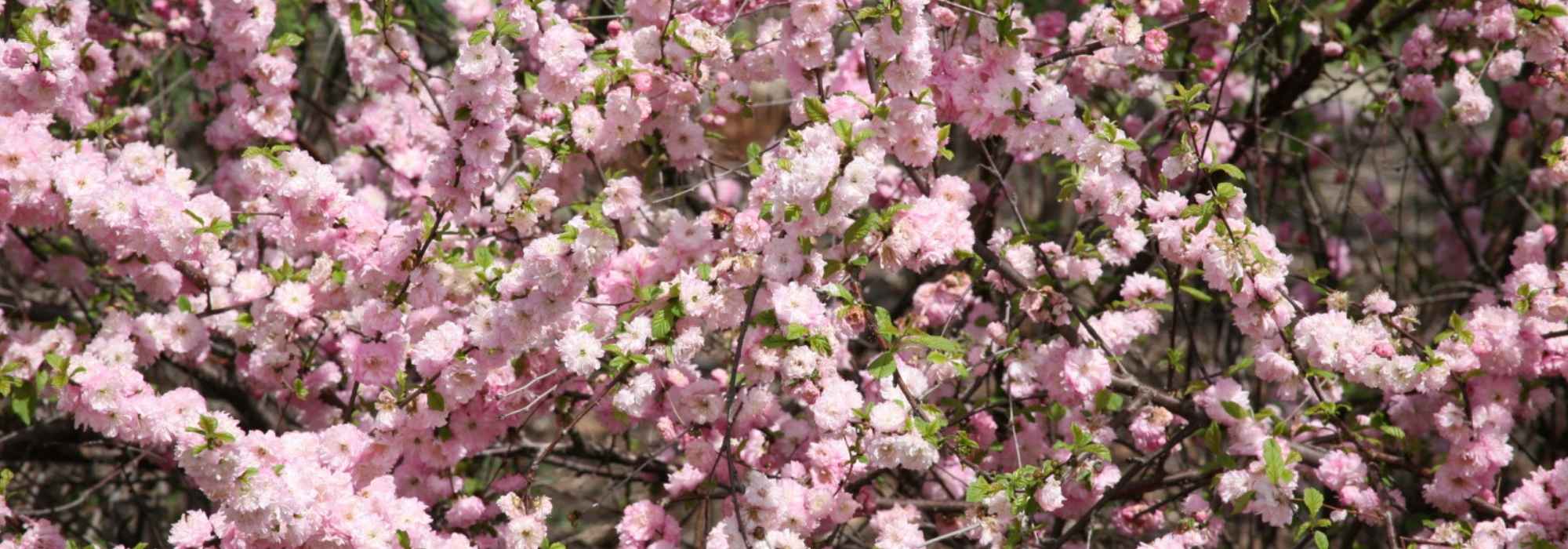
Flowering almond, Chinese almond: planting, pruning, care
Contents
Flowering almond in a nutshell
- Flowering almond is one of the first bushes to flower in the garden in late winter
- In spring, it offers wonderful early flowering in pom-poms of fresh pink or pure white before leaves!
- Its foliage changes colour with the seasons, turning golden yellow in autumn
- It is hardy and easy to grow in ordinary soil, in full sun or partial shade
- With its modest silhouette, it fits equally well in borders or hedges; there are even compact varieties such as Prunus triloba ‘Multiplex’ that can be grown in pots
A word from our expert
Often mistaken for Japanese cherry, Chinese flowering almond (Prunus triloba), also called flowering almond is, like its close relative, a spectacular bush with very early spring flowering made up of small soft-pink or white pompom flowers dotting the twigs before leaves.
In the garden, it is often first to flower as winter ends, announcing return of fine weather. Prunus triloba, or “false almond”, does not produce fruit, unlike edible almond (Prunus dulcis).
The flowering almond’s display, tinged with innocence and poetry, has inspired many painters from Van Gogh to Pierre Bonnard.
Prunus triloba and its essential cultivar Prunus triloba ‘Multiplex’ with double flowers, form pretty bushes with a natural habit and compact pruning needs, very useful in small gardens and city gardens. With moderate growth, Prunus triloba ‘Multiplex’ can even be grown on a stem, adapts to culture in a pot or container, and can be trained as bonsai!
Highly appreciated for its floribundity and elegant silhouette, Chinese flowering almond is also at home in all natural gardens as well as in romantic-style English gardens, to which it brings freshness and poetry in spring.
Hardy, it is easy to grow in sun or partial shade, in ordinary, rather cool but well-drained soil, sheltered from wind and stagnant moisture.
Discover our tips to grow, prune and care for the flowering almond, this exceptional bush with spring flowering that guarantees a show in the garden from the very first signs of spring!
Description and botany
Botanical data
- Latin name Prunus triloba
- Family Rosaceae
- Common name Chinese flowering almond, flowering almond
- Flowering March-April
- Height 1.20 to 4 m
- Sun exposure sun, partial shade
- Soil type all, well-drained
- Hardiness -15°C
Prunus triloba, better known as the Chinese flowering almond, flowering almond or the “false almond”, is a beautiful bush prized for its early spring flowering, one of the first to celebrate the return of spring. Contrary to what its name suggests, the Chinese flowering almond, unlike the almond tree, does not produce edible fruit.
Native to the mountains of northern China, it belongs to the large Rosaceae family, like almond, peach, plum, apricot and the flowering cherry or Japanese cherry, to which it is very closely related.
Although the genus Prunus includes about 250 species of trees and shrubs, only a few rare double-flowered horticultural forms of Prunus triloba are in cultivation, such as Prunus triloba ‘Multiplex’, a cultivar preferred to the wild-type species for its smaller, more compact habit and its pompom-like flowers.
Of normal growth and endowed with good longevity, the flowering almond forms a bushy, very branched bush with long shoots. It has an erect habit that tends to become slightly spreading with time, giving the crown a rather rounded shape. Prunus triloba will reach 3 to 4 m in height with a spread of about 2 to 3 m, a modest size that makes it suitable for urban small gardens. Its slender silhouette when young densifies over the years. The Chinese flowering almond can be left as a multi-stemmed bush or trained as a single-trunk tree.
With a more compact development, Prunus triloba ‘Multiplex’ will not exceed 1.50 m in height with about 1.20 m spread and can even be grown as a bonsai and pruned into a small tree with a Japanese-style silhouette.
The Prunus triloba has a beautiful glossy reddish-brown bark.
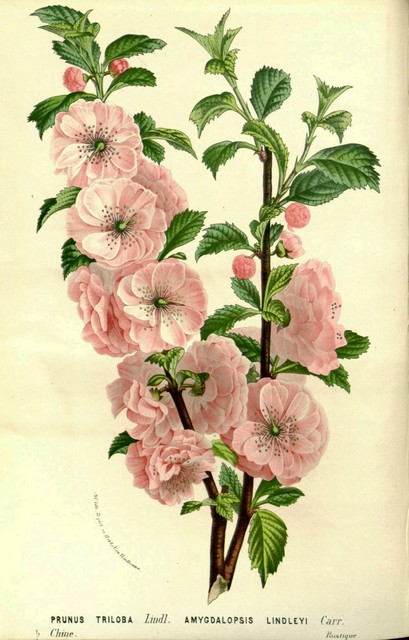
Prunus triloba – botanical illustration
Bright, generous and early, the Chinese flowering almond’s spring flowering, eagerly awaited each year, provides an unforgettable if fleeting spectacle. In the garden, it is one of the first bushes to bloom, when most plants are only just waking. At the end of winter, it is literally covered with clusters of remarkable flowers because they appear before the leaves, carpeting the still naked, softly haired reddish-brown wood with an extremely light floccose cloud.
Flowering begins in February in mild climates, in March–April elsewhere, just before the foliage appears. Small flowers 2 to 5 cm in diameter open by the dozen, singly or in pairs along one-year-old shoots. Cup-shaped to more or less spreading, they are simply formed of five petals in the wild species, and more generally very double, resembling small pompoms or miniature old-fashioned roses with their multiple ranks of petals. They reveal clusters of yellow stamens.
Delicate and airy, the Chinese flowering almond’s flowers are ordinarily a tender, fresh pink, though there are varieties such as ‘Albo plena’ with white flowers. These fleshy shades give the garden a hint of innocence and poetry, reinforced by the brevity of this flowering which lasts only three weeks. A few bare branches studded with barely showing flower buds will quickly open in a vase indoors.
Blown by the wind, the petals scattered on the ground form pink or white floral carpets at its feet, visible from afar and highly decorative.
After flowering, the flowers fairly rarely produce small ovate non-edible fruits that resemble tiny bright red olives.
The deciduous foliage follows flowering. Leaves 5 to 7 cm long are alternate, ovate, dentate-edged and cut into three small lobes at their tip, hence the species name “triloba”. Mid to bright green, paler and pubescent beneath in spring, the foliage takes lovely golden-yellow tones in autumn before falling.
Undemanding as to soil and climate, perfectly hardy in our climates down to -10 to -15 °C, the Chinese flowering almond can be planted in any garden in full sun or partial shade, sheltered from cold winds. It adapts to any ordinary soil, even calcareous, with a slight preference for cool, deep soils.
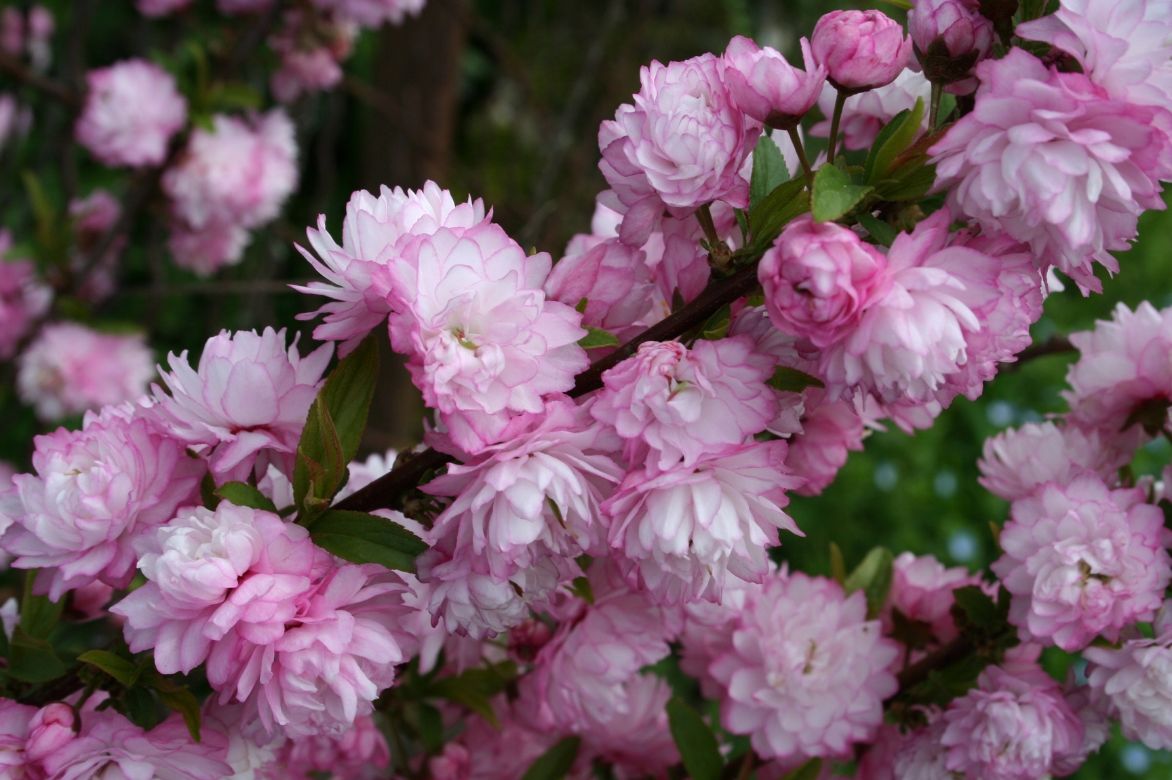
Flowering almonds are well suited to a small garden and perfect for city gardens. Prunus triloba makes a very handsome specimen tree to set alone on a short grass meadow, in the centre or at the back of a border, as a focal point for an avenue. With its more modest and compact dimensions than the wild Chinese flowering almond, Prunus triloba ‘Multiplex’ will be used in a loose hedge, trained against the wall of a walled garden or even in a pot on a terrace.
Venerated in China almost as much as the flowering cherry, the flowering almond symbolises awakening and recklessness, because it blooms early and risks being hit by late frosts.
Main species and varieties
Our nursery offers the most iconic Flowering Almonds: Prunus triloba is the type species, wild Chinese almond. Only a few rare horticultural double-flowering forms are found, such as Prunus triloba ‘Multiplex’, the best-known cultivar and most appreciated for its smaller, more compact habit and delicate pompom-like flowering.
Most popular
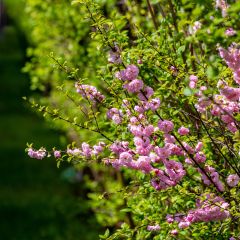
Prunus triloba - Flowering Almond
- Flowering time March to May
- Height at maturity 3,50 m
Our favourite
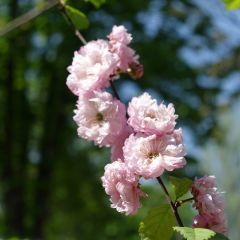
Prunus triloba Multiplex - Flowering Almond
- Flowering time March to May
- Height at maturity 1,50 m
Planting
Where to plant Prunus triloba or Chinese flowering almond?
Hardy down to -10 to -15 °C, the Flowering almond grows in all regions.
In cold climates, however, it prefers a position well sheltered from cold winds and late frosts that can damage its early flowering: in northern and eastern France, plant it, if possible, sheltered by a wall.
It prefers sun but not scorching sun; opt for light shade in hot regions.
Undemanding in a sheltered spot, it grows in any good garden soil, even poor or calcareous, although it prefers rich, deep soils that remain cool. It only dislikes heavy, waterlogged soils: plant it in fresh, well-drained ground. If you live in a region with heavy rainfall, favour planting on a mound or bank where water will not pool.
Although its small size makes it suitable for use in small enclosed gardens and in city gardens, give it enough space to allow for future development.
Plant it as a specimen in the middle of a short grass meadow or as a focal point at the end of an avenue to better appreciate its flowering. You can also grow it as a free-flowering hedge with other spring-flowering bushes, or in a row. It will also find its place alone or in groups at the back of a spring perennial border against a backdrop of evergreen foliage that will showcase its softly coloured flowers.
More compact varieties, such as ‘Multiplex’, can be grown in pots, even trained as bonsai, and placed for example in a Japanese garden, on a terrace sheltered from prevailing winds or in a patio. It can also be trained against a wall near the house to enjoy its flowering.
When to plant Prunus triloba or Chinese flowering almond?
Our flowering almonds in pots can be planted from October to March, avoiding periods of frost or extreme heat. Planting in autumn, from September to November, will give the bush time to establish before winter so it can flower in spring.
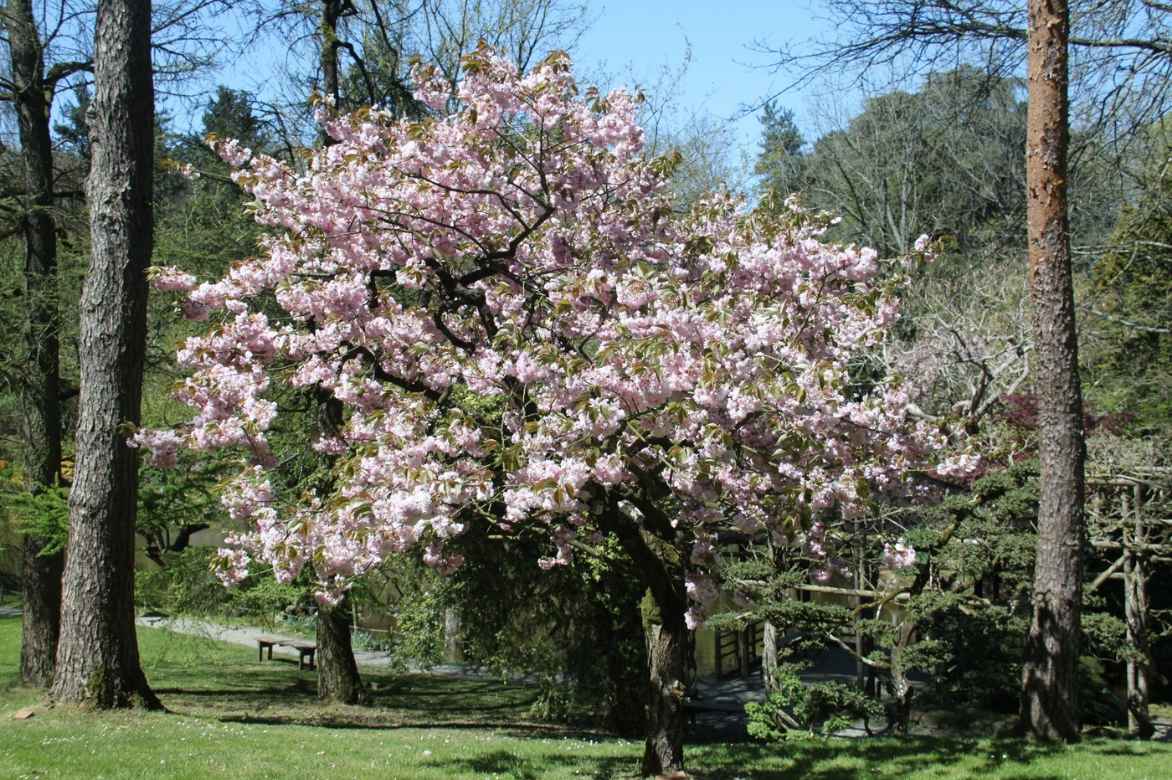
How to plant Prunus triloba or Flowering almond?
In open ground
The Prunus triloba prefers deep soil fairly rich in organic matter. We recommend adding well-rotted compost when planting. It can also be planted in groups of 3 or 5, in clumps, which will provide a truly spectacular display from late winter. And don’t miss any step of our step-by-step guide to planting a bush correctly!
- Soak the rootball in water
- Dig a hole at least 60 centimetres wide and just as deep
- Loosen the bottom well with a spade
- Add pumice to ensure good drainage, especially in heavy soil
- Place the bush in the centre of the hole, collar level with soil
- Backfill the hole with the excavated soil mixed with well-rotted compost
- Firm soil with your foot and water well at planting and regularly during the first summer so soil remains cool
As a hedge
- In a hedge, space flowering almonds 1 m apart and plant in a trench 30 to 50 cm deep and 20 to 30 cm wide.
In pots
Choose a small-growing Prunus triloba ‘Multiplex’.
- Use a container large enough (minimum 50 cm diameter), and lay a layer of clay pebbles or pumice
- Plant the bush in a mix of garden soil and good-quality potting compost to which you add a little sand
- Choose a sunny spot or partial shade in southern regions
- Water regularly when potting mix dries out
Read also
Pruning spring-flowering bushesMaintenance, pruning and care
Low-maintenance, hardy, once well established, Flowering almond requires little attention. It is advisable to water your bush regularly in summer and winter during first two years, and especially in dry spells. Afterwards, water only during periods of very hot weather. Mulch its base with an organic mulch of fallen leaves to keep soil cool.
In a pot, watering must be more regular but not excessive: water as soon as soil is dry at surface. Repot every two years into a larger container.
Apply well-rotted compost around base of bush each year at start of spring to encourage growth from season to season.
When and how to prune a Prunus triloba or Flowering almond ?
Pruning of Prunus triloba should always be carried out after flowering. It is not obligatory but helps keep bush balanced and promotes appearance of new floriferous shoots the following spring. After pruning, apply wound-sealing paste to all wounds to prevent gummosis (secretion of a natural viscous amber-coloured gum) to which bush is susceptible. Follow all our advice to prune an early-flowering bush properly!
To harmonise its habit in a clump and maintain abundant flowering:
- Each year, at end of flowering, give maintenance pruning: with a pruning shear, shorten at base all shoots that have flowered by at least half, even two thirds of their length, just above a large bud
- Remove thin branches, crossing branches and those growing towards centre of clump to ventilate centre of branches
- Remove dead wood by cutting above a bud
An old specimen will tolerate being cut back hard to rejuvenate it: for this rejuvenation pruning, cut oldest branches back to ground level with a pruning saw if necessary.
To train a Flowering almond or Chinese flowering almond as a standard:
This training pruning is recommended when bush is young.
- Prune lower branches just above an eye
- Prune all young shoots back to two eyes
Chinese flowering almond in a pot :
- Prune to two eyes the shoots that have flowered in spring to keep a modest size

Diseases and potential pests
Flowering almond shows fairly good resistance to diseases.
In summer, however, scale insects may attack its foliage, which then tends to curl and dry out. To control them, in spring treat the stems with sprays of vegetable oil (rapeseed or olive oil) mixed with 90% alcohol and black soap. If infestation is severe, cut and burn infected parts.
Black aphids are also responsible for the appearance of sooty mould, a harmless but unsightly condition that leaves a black, soot-like deposit on the leaves, which eventually curl in on themselves: treat by spraying black soap onto the foliage.
In poorly drained or overly compact soil, it can also be affected by certain fungal diseases causing foliar spots: cut and burn affected parts, then treat with Bordeaux mixture.
Propagation
Propagation of Chinese almond or flowering almond can be done by semi-ripe cuttings, but cuttings are fairly difficult to succeed with, as establishment is delicate; they are carried out in a greenhouse, require high humidity and a plant hormone for propagation by cuttings. To improve chances of success: propagate cuttings under cover.
- In July, take semi-ripe cuttings with a heel
- Dip cuttings in plant hormone for propagation by cuttings
- Plant them in a tray in a light mix of river sand and turf
- Moisten substrate
- Wrap tray in a closed plastic bag and keep at 20°C
- Keep substrate moist until rooting, which takes 1 to 3 months
- Pot on rooted cuttings individually in October–November into light potting compost and keep in a plastic bag throughout winter
- Plant out cuttings in open ground the following spring; flowering occurs in first year
Combine
Like its cousin Japanese cherry, the Chinese flowering almond is an essential bush in spring scenes, bringing freshness and poetry. It finds its place in all natural gardens, in large spaces as in small city gardens and even when creating a Japanese garden! It asserts itself in romantic compositions, where it proves to be centrepiece in spring in a pink garden or white.
With its spectacular flowering and unique silhouette, Chinese flowering almond is perfect as a specimen and often stands alone. However, with its moderate size, it fits easily in a mixed border or in a flowering hedge surrounded by plants whose flowering coincides with its own.
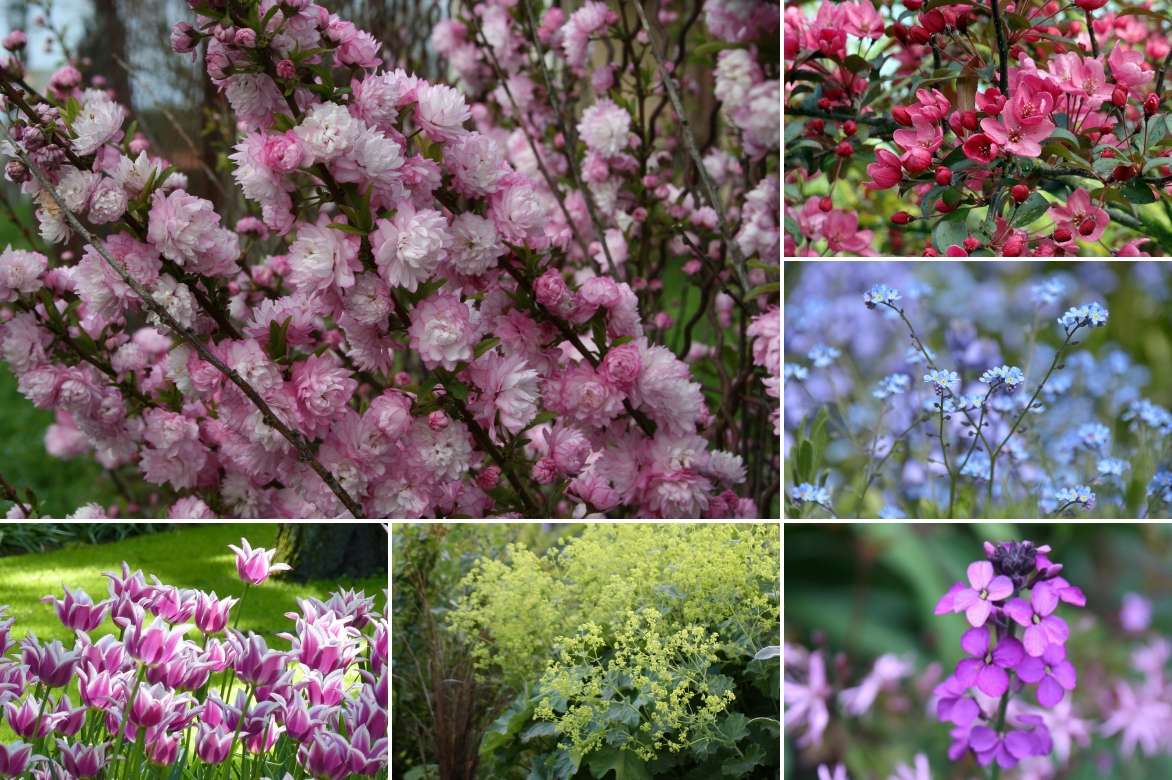
A planting idea: Prunus triloba, Malus ‘Liset’ (or ‘Coccinella Courtarou’, ‘Prairie Fire’ or other), Myosotis, Erysimum ‘Bowles Mauve’, Alchemilla mollis and Tulip ‘Ballade’
It will be among first to herald return of warm days, alongside a magnolia, forsythias with their dazzling flowering, or in a similar tonal harmony, an Abeliophyllum distichum, Japanese cherries and quinces.
In a flowering hedge, it pairs easily with other spring-flowering bushes such as Lilac, Japanese Kerria, Ribes x gordonianum, or Calycanthus, which will take over from spring into summer.
As backdrop to a border, its pastel flowering will stand out beautifully against a canvas of dark foliage from laurels, thujas, yews.
To wake garden at end of winter, compose beautiful spring scenes by accompanying your flowering almond with early-flowering bulbs, such as muscari, botanical tulips, daffodils or hyacinths, squills… and possibly spring perennials such as primroses, forget-me-nots, winter heathers or hellebores. Complete picture by pairing its pink or white flowers with bluish foliage of hostas or some grasses such as fescues.
With flowers appearing in profusion on bare wood, Chinese flowering almond inspires creation of a zen mixed border when surrounded by grasses, cloud-pruned pines, Japanese maples, bamboos, Hakonechloa macra and ericaceous plants such as azaleas and camellias.
In a pot, plant small spring bulbs at its base, tulips or daffodils in delicate shades for a lovely tonal effect in pink.
Useful resources
- Discover Japanese cherry trees and other ornamental Prunus, by Franck Sadrin, published by Editions Ulmer (2014)
- They herald the arrival of spring: the most beautiful spring-flowering bushes are available here!
- Subscribe!
- Contents
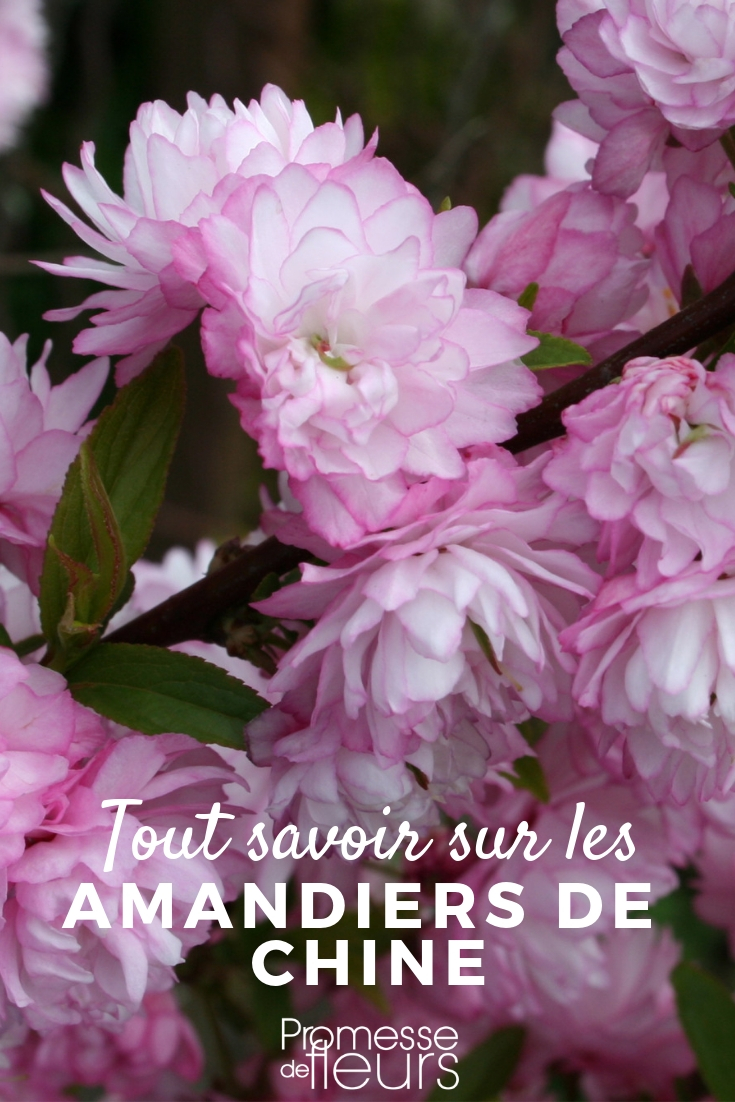































Comments